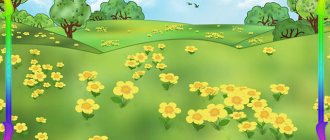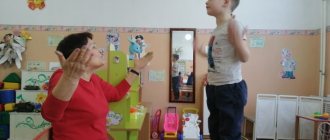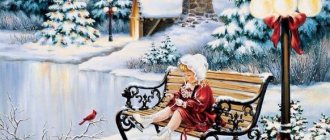Junior group. Early childhood, nursery. Children 1-4 years old
Entertainment “Farewell to the Christmas tree” (junior group) Methodological development Entertainment “Farewell to the Christmas tree”
(junior group)
Educator: -Guys, guess the riddle: A guest came to us from the edge of the forest - Zelena, at least not a frog. And it’s not Mishka who is clubfooted, even though her paws are furry. And we can’t understand, what does she need the needles for? She's not a seamstress, she's not...
Scenario of a holiday dedicated to March 8 for a group of young children “Masha visiting the children” Children are sitting on chairs Presenter: We dressed up today. Let's sing and dance, Let's have fun together, Congratulate our mother. Let Songs, music and laughter sound in the hall today, We are very happy to congratulate mothers, Everyone: Our mothers are the best! (thumbs up)
Host: Mom is...
Long-term plan for sports events, entertainment, and leisure activities in the second junior group
Long-term plan for sports events, entertainment, and leisure activities in the second junior group
(group No. 4 “Sun”, group No. 8 “Stars”) MBDOU d/s No. 55 for the 2014-2015 academic year.
| Month | Form of conduct | Name |
| September | Sports and music festival | "Day of Knowledge" |
| October | Leisure | "Kolobok" |
| November | Entertainment | “We invite the kids to a fun game” |
| December | Leisure | "Our merry Teremok" |
| January | Holiday Leisure | "Winter Fun" "In Search of the Snowman" |
| February | Entertainment | "My funny ringing ball" |
| March | Holiday | "Let's play sports" |
| April | Leisure | "Physical training for a bunny" |
| May | Entertainment | "On a visit to the sun" |
| June | Holiday | "Hello, red summer" |
| July | Leisure Entertainment | "Jump-jump, jump-jump, Jumping is fun my friend" "Visiting Matryoshka" |
| August | Leisure | "Water-water" |
Long-term plan for sports events, entertainment, and leisure in the middle group (group No. 3 “Droplets”, group No. 5 “Flowers”) of MBDOU d/s No. 55 for the 2014-2015 academic year.
| Month | Form of conduct | Name |
| September | Sports and music festival Leisure | "Day of Knowledge" "My funny ringing ball" |
| October | Entertainment | “Autumn has come to visit us” |
| November | Entertainment Leisure | "Autumn festivities" “The kids really need sports, we are very friendly with sports” |
| December | Entertainment | "Visiting the winter-winter" |
| January | Entertainment | "New Year's trip with the Snowman" |
| February | Outdoor leisure Holiday | "Winter Fun" "Together with Dad" |
| March | Leisure | “We celebrate Maslenitsa and say goodbye to winter” |
| April | Sports and music festival | “April 1st – I don’t trust anyone” |
| May | Entertainment | "Naughty Balls" |
| June | Sports and music festival | "Children Protection Day" "Bubble" |
| July | Entertainment | "Visiting Summer" |
| August | Entertainment Entertainment | "Day of outdoor games" "Sports Games Day" |
Long-term plan for sports events, entertainment, and leisure activities in the senior group (group No. 6 “Teremok”, group No. 7 “Fairy Tale”)
MBDOU d/s No. 55 for the 2014-2015 academic year.
| Month | Form of conduct | Name |
| September | Musical and sports festival | "Day of Knowledge" |
| October | Leisure Entertainment | “We reap the harvest and increase our health” “Sports relay races” |
| November | Entertainment Leisure | "Favorite games" "Bouquet for Mom" |
| December | Leisure | "One hundred ideas for friends" |
| January | Entertainment Leisure | "Small Olympic Games" "Winter's Tale" |
| February | Holiday | "Good Soldiers" |
| March | Entertainment Leisure | "Let's play sports" "Come on, girls" |
| April | Entertainment Leisure | "Just a little bit" "Space trip" |
| May | Holiday | "Victory Day - Grandfathers' Day" |
| June | Entertainment Leisure | "Long live children all over the planet" “The whole planet welcomes summer” |
| July | Leisure | “Temper yourself if you want to be healthy!” |
| August | Holiday | Neptune Festival |
Long-term plan for sports events, entertainment, and leisure activities in the preparatory group
(group No. 2 “Gnomes”) MBDOU d/s No. 55
for the 2014-2015 academic year.
| Month | Form of conduct | Name |
| September | Sports and music festival | "Day of Knowledge" |
| October | Entertainment City sports competitions | "Sports garden" "Fun Starts" |
| November | Entertainment Leisure | "Journey to the Planet of Balls" "Bouquet for Mom" |
| December | Leisure | "One hundred ideas for friends" |
| January | Entertainment Leisure | "Winter Fun" "Journey to the Land of Fairy Tales" |
| February | Sports and music festival | "School of a Young Fighter" |
| March | Entertainment Leisure | “Come on, girls” “Maslenitsa” |
| April | Sports holiday Leisure | "Health Day" "Space trip" |
| May | Leisure | “Let's play war games” for the Day |
| June | Entertainment Sports fairy tale | "Long live children all over the planet" "Snow White and the Seven Dwarfs" |
| July | Leisure Entertainment | "Call of the Jungle" "Russian folk games" |
| August | Holiday | Neptune Festival |
I affirm:
Head of MBDOU d/s No. 55________________
" "___________ 2014
Long-term plan for sports events, leisure, and entertainment in MBDOU d/s No. 55
for the 2014-2015 academic year.
Get text
Leisure summary “Let's help the birds in winter” in the younger group
Leisure summary
“Let's help the birds in winter” in the younger group.
Integration of educational areas:
“Cognition of FEMP”, “Communication”, “Socialization”.
Goals:
• expand children's knowledge about the life of birds in winter, their habits, and nutrition;
• give children an idea of the types of food of wintering birds; • develop visual perception, coordination of movements; • develop observation skills, ability to compare, establish cause-and-effect relationships; intelligence in the process of solving riddles; • develop children's cognitive interest in the life of birds; • cultivate empathy, sympathy, and the desire to help birds in difficult winter conditions. Materials for the lesson:
audio recording “Voices of wintering birds”;
laptop; feeder; pictures depicting a sparrow, bullfinch, tit, crossbill; four saucers with rowan berries, seeds, a cone, a piece of lard; didactic game “Feed the bird”. Preliminary work:
• observing birds during walks;
• examination of didactic pictures “Wintering Birds”; • didactic game – puzzles “Birds in Winter”. Progress of the lesson 1. Organizational moment.
Educator –
Look how strong the wind is outside! A snowstorm swirled and spun us around. Look where we ended up - in the winter forest. How beautiful it is all around! But why is it so quiet? (Many birds flew away.)
Educator –
Yes, many birds have flown away, but not all. But in our forest, I cannot see a single bird. The birds hid from us, but if we listen carefully, we can hear their voices. Let's repeat with the birds what they sing:
-Chik-chirik (Sparrow).
-Tsok-tsek, tsok-tsek. (Crossbill).
-Rum-rum-rum. (Bullfinch).
-Ting-ting-ting. (Tit).
Educator–
So what birds stayed with us for the winter? (Bullfinch, tit, crossbill, sparrow). We can call them wintering.
Educator –
Guys, what benefits do birds bring?
(They bring joy, destroy harmful insects, and sing beautifully). Educator
- Wintering birds fly to our city from the forest for help. How can we help the birds?
I'll try to give you a hint - look what I brought? Educator
- That's right - it's a feeding trough.
And what is it for? (feed the birds in winter) Educator
- Guys, but since so many birds stayed with us for the winter, why did they fly past and not land on my feeder? (there is no food in the feeder).
Educator
-Oh, but I can’t remember something, what do birds eat in winter?
Guys, let's try to get to know the birds better together. 3. Work on describing and comparing birds. Educator
- Guys, look carefully at the birds and tell me how they are all similar?
(all birds have a body, head, legs, beak, wings, tail, and the body is covered with feathers). Educator
- Why do birds need wings?
(fly) Teacher
- Why do birds need paws?
(move on the ground, cling to branches) Educator
- Why do birds need a beak?
(eat, drink) - demonstration Teacher
- Guys, how do these birds differ from each other?
Educator
- That's right, they have different colors: the bullfinch has a red breast, and the tit has a yellow breast.
And the birds have different habits: sparrows like to sit on bushes, crossbills on spruce branches, bullfinches on rowan branches. Educator
- Guys, you are so great!
How much you told me about birds. Let's relax and jump like cheerful and nimble titmice. 4. Physical education.
A nimble tit is jumping, (jumping in place on two legs) She can’t sit still, (jumping in place on the left leg) Jump-jump, jump-jump, (jumping in place on the right leg) Spun like a top.
(spinning in place) So she sat down for a minute, (sat down) Scratched her chest with her beak, (stood up, tilted her head left and right) And from the path - onto the fence, Tiri-tiri, Shadow-shadow-shadow! (jumping in place on two legs) 5. Conversation “Who eats what?” Teacher
- Titmouse - the guys jumped, warmed up and the birds wanted to eat.
But we still haven’t figured out what different birds like to eat. In summer and autumn, tits and sparrows fed on beetles, grasshoppers, and caterpillars. But now, in winter, beetles and grasshoppers sleep under two blankets - autumn and winter, and cannot be reached. In winter, birds are cold and hungry. It is difficult for birds to find food under the snow. And you and I can help them by opening a poultry canteen. Let's create a menu for the bird's canteen. Educator
- Guys, tell me, what do birds eat?
(bread, crumbs, seeds). Educator
- That's right, guys. Look, I have some more treats on the table for wintering birds.
Let's find out which bird is pecking what. Melon and pumpkin seeds are pecked by crossbill, bullfinch, and sparrow. Tits love sunflower seeds and lard. Sparrows and tits peck at the oats. Millet and millet are the favorite food of sparrows. Rowan and viburnum berries are the favorite food of bullfinches. Continuation of the conversation “Who eats what?” Repetition: Educator
- Sparrows feed on grains, crumbs, and seeds.
Educator
- Tits feed on grains, crumbs, seeds, their favorite delicacy is lard.
Educator
- Bullfinches eat seeds and love to peck rowan berries.
Frozen berries respond well to a powerful bite. Shows a saucer with rowan berries. 7. Game “Feed the bird.” Educator
- Look carefully, we have saucers on the table: with rowan berries, bread crumbs, seeds.
Educator
- I will show you pictures of birds, and you must name the bird and find food for it.
8. Finger gymnastics “Wintering birds” Educator
- Now let’s practice feeding the birds.
Come, birds! (“calling” movements of the fingers) I will give lard to the titmouse (4 times – “cutting” movements of one palm on the other) I will prepare the crumbs (fingers with a pinch – “crumbing the bread”) A little bread. These crumbs are for the pigeons (extend your right hand forward with an open palm) These crumbs are for the sparrows (the same with your left hand) Jackdaws and crows Eat pasta! (rub palm against palm, “rolling pasta from bread”). 9. Summary of the lesson.
Summary of physical education and mathematics leisure in the second junior group “Mathematical adventures”
Goal: Development of children's mathematical abilities through physical development.
Tasks:
Educational: Expand the ability to find one or many objects in a specially created environment. Continue learning to distinguish between a circle and a square. Compare circles by size: large, small.
Developmental: Develop activity, curiosity, speed, dexterity, attention.
Educational: Cultivate friendships and partnerships in children. Foster independence, interest and emotional responsiveness.
Attributes: Driver's hat, circle, square, cubes, balls, hoops, flat Snowman, magnetic board, pyramid, two boards wide and narrow.
Equipment: Laptop, musical accompaniment.
Leisure activities:
Children enter the gym. They are under construction. Warm-up is in progress.
Educator: Today we will go on an exciting journey. Let's go by train. I will be your driver. Get ready and let's go! Chug-chug! (music turns on). The children are traveling by train.
Look, the first stop is “Kvadratnaya”. Now we will build a large and a small house from cubes. You will need to build cube by cube. Our cube is square in shape. Show! A square has four corners. What kind of cubes do we have?
Big and small. Children are called. The teacher suggests building a large house, then the children build a small house. We compare who got a big house and who got a small one. Well done!
Let's move on. The music turns on. Children are traveling by train. The next stop is “Round”. Children look at the circle. The teacher invites the children to assemble a flat Snowman on a magnetic board. Find out what shape the circle is. Show! Tell that the large circle is attached first, then the medium one, and finally the small one. Children are called. We add a bucket, carrots, arms, and legs to the Snowman. Well done!
Task: “Assemble a pyramid.”
We specify the pyramid shape and color. The child is called. Well done!
Our train continues to move. The music turns on. Next stop “Sportivnaya”.
Assignment: “Collect balls and cubes in your baskets.”
At a signal, children collect balls in one basket and cubes in another. We check how the children completed the task. Well done!
Educator: Guys, let's move on. The music turns on. The next stop is “Wide - Narrow”.
First, the children walk one after another along a wide path, then along a narrow one.
And now we will play an outdoor game. The game “Birds in Nests” is played.
Children run in all directions without bumping into each other. At the signal “The birds have flown,” children fly out of their nests and fly. At the signal “Birds, go to their nests!” the children return to their places. For nests, hoops placed on the floor are used.
Summing up.
Guys, what did we travel on today?
By train!
We went on a trip to the stops “Kvadratnaya”, “Round”, “Sportivnaya”. We completed tasks and played an outdoor game. You are so great today! And now we will take a photo for memory.


